The 2014 LCGC Awards
LCGC North America
The winners of LCGC's seventh annual awards are highlighted.
The seventh annual LCGC Awards continue the time-honored tradition of celebrating the careers of outstanding chromatographers. We are proud to announce that the 2014 Lifetime Achievement in Chromatography Award is granted to Fred E. Regnier and the 2014 Emerging Leader in Chromatography Award is presented to André de Villiers. Table I shows the complete listing of our prestigious award winners over the past seven years.
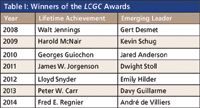
Table I: Winners of the LCGC Awards
Fred E. Regnier
One of the greatest aspects of the LCGC Lifetime Achievement in Chromatography Awards is that it presents us with the opportunity to appreciate the legacy and scientific impact of our winners. The passion and insight these scientists offer the community cannot easily be expressed, but everyone we interview gives resounding comments in that regard. For Fred E. Regnier, the passion, legacy, and scientific impact are just a few of his many achievements in a life-long scientific journey.
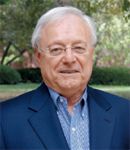
Fred E. Regnier
Regnier's path to chromatography did not start in the usual fashion. He says that he came to science "through the back door." "Getting into science didn't occur to me until I was out of college," he adds. In fact, he claims he only started college as a way to get out of working outside in the cold Nebraska winter. Despite his professed lack of interest in science early on, as an undergraduate at Nebraska State College Regnier had a triple major in physics, chemistry, and math — quite an undertaking! It was during those undergraduate years that Regnier first came across separation science — while shelving books at the library on chromatography and electrophoresis. Those subjects clearly captured his interest; Regnier's undergraduate thesis was on paper electrophoresis of amino acids. After graduating from Nebraska State College in 1960, Regnier went on to get his PhD from Oklahoma State University in 1965. The focus of his doctoral dissertation was the biosynthesis of terpenes and pheromones.
Regnier went on to do postdoctoral research at Oklahoma State University in 1965, the University of Chicago from 1966 to 1967, and Harvard University in 1968. That work at Harvard, under the direction of Ed Wilson and John Law, focused on the identification of insect hormones and pheromones. He built a high performance liquid chromatography (HPLC) system to purify trail pheromones from 100-lb bags of fire ants and also did work with gas chromatography (GC) and mass spectrometry (MS).
Following his postdoctoral research, Regnier took an assistant professor position in the biochemistry department at Purdue University, where he began a long-lasting professorship that would span more than four decades. He was promoted to associate professor of biochemistry in 1971. In 1976 he was promoted to associate director of the agricultural experiment station and then to full professor of biochemistry. In 1990 his title changed to a professor of chemistry, and in 2004 he became the John H. Law distinguished professor of chemistry.
Major Scientific Contributions
Regnier is known as an innovator who has often bridged the gap between biochemistry and analytical science. He cites Wilson and Law as big influences in that regard. "They told me I should focus on method development, their rationale being that developing new, innovative, original methods always keeps one at the cutting edge," said Regnier. "'You will always be relevant,' they said."
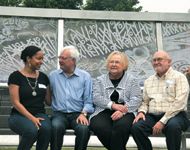
Figure 1: Regnier with his wife Linda and his first and last PhD students. From left to right: Nishi Rochelle (PhD 2011), Fred Regnier, Linda Regnier, and Peter Dunn (PhD 1973).
Regnier took that advice to heart: Among his many accomplishments, he has received 45 patents related to the separation and detection of proteins and peptides. His work includes developing the first high-performance chromatography columns for size-exclusion chromatography (SEC), anion-exchange and cation-exchange chromatography, hydrophobic interaction chromatography (HIC), and macroporous reversed-phase chromatography separations of proteins; describing "footprint" retention models for ion-exchange chromatography (IEC), HIC, and reversed-phase chromatography of proteins; fabricating a variety of capillary and collocated monolith support structure capillary electrochromatography systems; and synthesizing multiple polymeric bonded phases for SEC, IEC, HIC, and affinity chromatography that enabled silica, titania, zirconia, alumina, and poly(styrene–divinylbenzene) supports to be used for protein separations; and the synthesis of gigaporous chromatographic media with enhanced mass transfer and pore diameters exceeding 400 nm.
When we asked Regnier's colleagues, past students, and friends about his biggest contributions to the field, the responses were as varied as his work. Barry Karger, the James L. Waters Chair in Analytical Chemistry and the director of the Barnett Institute at Northeastern University, feels Regnier's biggest contribution was the development of perfusion particles for preparative-scale separations of biopolymers. "These packings, developed over 25 years ago, are still widely used today for purification," he said.
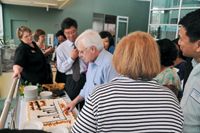
Figure 2: Regnier’s retirement party. Note the chromatogram on the cake.
Tim Schlabach, a marketing manager at Agilent Technologies and a former graduate student of Regnier's, agrees with Karger. "Critical advances in the fast separation of biomolecules including size-exclusion, ion-exchange, and perfusion chromatography were Regnier's biggest contributions," Schlabach said.
Joseph J. Kirkland, vice-president of R&D at Advanced Materials Technology Inc., points to Regnier's work characterizing biomolecules using HPLC. "Regnier was an early leader in recognizing the potential of HPLC for characterizing biomolecules and establishing effective research programs to demonstrate this as a premier method," said Kirkland. "His contributions in this area have been enormously important in describing new science that has had a serious impact on improving health issues."
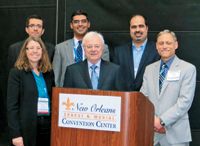
Figure 3: 2013 ACS medal symposium. Back row, left to right: Ashraf G. Madian, Samir Julka, and Hamid Mirzaei. Front row, left to right: Mary Wirth, Fred Regnier, and Andy Alpert.
Wolfgang Lindner, a professor emeritus at the Institute of Analytical Chemistry at the University of Vienna, believes that Regnier's knowledge of biochemistry, proteins, and biological systems led to his biggest contributions. "Regnier was always aware of the complexity of biological samples and systems and the great demand to have tools available to deconvolute the samples' complexity," said Lindner. He went on to explain that this awareness allowed Regnier to advance concepts of how LC can separate biomolecules, including peptides and large proteins. "This knowledge makes Regnier a very unique scientist indeed," he said. "There are not many colleagues in the world who have this spectrum of insights in the biochemical and separation science fields."
Karger echoed this sentiment. "Regnier combined his biochemical background with separation principles in very creative ways," he said. "He has made significant contributions to the advancement of separation science over this career."
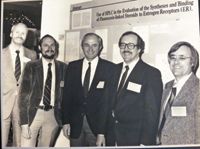
Figure 4: The chairmen at the 2nd ISPPP conference in December 1982, in Baltimore, Maryland. From left to right: Jan-Christer Janson, Tim Wehr, Klaus Unger, Milton Hearn, and Fred Regnier.
Tim Wehr, a staff scientist at Bio-Rad Laboratories, agreed that Regnier did groundbreaking work with biomolecules. "Fred is a pioneer in the field of HPLC of biomolecules, and the first large-pore chromatography columns designed specifically for protein separations were created in his lab," Wehr said.
Michael Dong, a senior scientist at Genentech, thinks that Regnier's greatest contributions were not just his work advancing the fundamentals of protein separations and microfluidics, but also "the idea of using analytical chemistry to solve the most important questions for mankind, which are mostly in biology."

Figure 5: Pat Sandra with his former coworkers in April 2008 in Stellenbosch, South Africa. From left to right: Pat Sandra, Frédéric Lynen, Andreas Tredoux, André de Villiers, Deirdre Cabooter, and Martina Sandra.
Xiang Zhang, a professor of chemistry at the University of Louisville, agrees with Dong. "Regnier's contribution to separation science is not only his development of chromatography systems for protein and small molecule separations, but also the application of these technologies to solve real-life problems," Zhang said.
Ira Krull, a professor emeritus of Northeastern University, points to the specifics of many of Regnier's contributions, such as the development of new stationary phases or instrumentation for HPLC separation of biopolymers, immobilized enzyme reactors, chip-based HPLC separations, and biopharmaceutical characterization. "Regnier has made countless contributions in separations, mostly in new and novel stationary phases, and instrumentation such as the Bio-Cad systems from PerSeptive Biosystems and other small firms that Regnier started." Krull is referring to one of the five companies related to separations and analytical chemistry that Regnier cofounded: Bioseparations, PerSeptive Biosystems, BG Medicine, Quadraspec, and Perfinity Biosciences.

Figure 6: De Villiers at Cape Point, South Africa.
Andrew Alpert, the president of PolyLC, Inc., and a former graduate student of Regnier's, also feels strongly about Regnier's work on the commercial side of analytical science. "Regnier ensured that his inventions became commercial products so that scientists everywhere would have ready access to them, and sometimes he started the companies needed to implement this," said Alpert. "That example particularly inspired me."
Alpert also points to Regnier's work adapting every mode of chromatography used for life-science separations from low-pressure media to HPLC media, adding that Regnier systematically worked out the requirements for a successful or optimal material in such applications. "In some cases, there was no precedent for this," Alpert said. "This set the agenda for everyone who has followed in that field."
Academic Contributions
Regnier was not only interested in developing products, however. He also focused on the development of his students. As an educator for more than 40 years, Regnier mentored more than 80 graduate students and more than 30 postdoctoral researchers. Edward Pfannkoch, the director of technology development in North America for Gerstel Inc., and a former graduate student of Regnier's, emphasizes the importance of this aspect of Regnier's career. "It is easy to cite Regnier's many contributions such as his fundamental work on coating wide-pore silica for HPLC packings for biological separations," he said. "However, I feel one of his biggest contributions is the training, guidance, and example he set for a whole generation of students that are now working in areas related to separation science."
Deena Krestel-Rickert, the owner of Pettec, LLC, and a previous graduate student of Regnier's, agrees with Pfannkoch. She explained that Regnier is an innovative thinker, is a great speaker, is very well-liked and respected, and is extremely willing to help people both in their career and personal lives. "I was extremely fortunate to have been his student," Krestel-Rickert said. Schlabach also noted Regnier's willingness to help his students during both their academic and professional careers. "Regnier helped me on more than one occasion secure a position with a company, " he said.
Work in Regnier's laboratory was both challenging and exciting for many of his students. Alpert came up with a great analogy: "Working with Regnier was like panning for gold. His numerous ideas and concepts were like a rushing river. It was the job of his graduate students and postdocs to reach in and grab the gold nuggets as the flow carried them by — that is, to figure out which ideas were both practical and worthwhile to implement, then work out a way to do so."
Zhang added that Regnier had a broad vision of science and was always excited and full of passion about his research. "Everyone who worked with Regnier knew that he was always the right person to talk with about research and the source to get encouragement," Zhang said.
Jim Pearson, a partner at Bioscience Advisors and a graduate student of Regnier's, says that Regnier never told him what experiment to do; instead he let Pearson explore and discussed the results afterwards. "This instilled a sense of scientific curiosity in me, because I could test my own ideas and bounce the results off Regnier," he said. Pearson's favorite example of this was in 1980 when he coated various porous silicas with an experimental reversed-phase coating containing an adamantyl "box-like" group at the end of the n-alkyl ligand. The goal was to see if peptide or protein selectivity could be enhanced, and the silicas had various pore diameters, ranging from 55 to 1000 Å. "To my surprise, the 330-Å diameter porous silica worked the best by far, and I was excited about my adamantyl 'box-like' ligand find," he said. "Regnier just smiled when he saw the data because he knew I stumbled upon the understanding that the pore diameter effect is key for resolution." Regnier told Pearson to make an HPLC column with that 330-Å porous silica using a C8 ligand instead, which resulted in even better selectivity. "C8-coated 330-Å porous silica reversed-phase columns soon became the universal standard for peptide and protein separations for the next 25 years," said Pearson.
Pfannkoch had a similar experience of being given independence in Regnier's laboratory, with his first real exposure to HPLC instrumentation. Pfannkoch explained that Regnier had an HPLC instrument that was also used to pack HPLC columns, and someone had precipitated buffer in the lines. "Regnier handed me some wrenches and a manual and said, 'Fix it,'" said Pfannkoch. "After that day I was never intimidated by analytical instrumentation."
Krestel-Rickert also said that Regnier taught her a lot about HPLC and GC and entrusted her with maintaining the HPLC system. What was much bigger than that, however, was that Regnier took her into his laboratory under a National Science Foundation grant on dog olfaction after she lost her major professor at Florida State and still had two years left to complete her PhD. "Regnier made a lot of things possible for me and always had my and all of his student's best interests and futures in mind," said Krestel-Rickert.
Pfannkoch summarized Regnier's role as an educator nicely. "Regnier's leadership, enthusiasm, example, and humility serve as a tremendous role model for all the best in science," he said.
The affection that Regnier's students have for him was demonstrated recently when many of them gathered together for a surprise party in honor of his retirement from Purdue University in May 2013. Jianming Lei, an analytical chemist at the office of Indiana State Chemist at Purdue University and a former graduate student of Regnier's, helped to organize the party and reached out to all of Regnier's former students and colleagues to create a book of congratulation letters, stories, and photos of Regnier throughout the years, titled Fred Regnier's Indy 500 of Chromatography and Other Stories (1). A few of those photos are included here. In the book, Regnier's wife, Linda said that for Regnier, his students were "his life, his passion, and his pride and joy."
Contributions to the Field
Beyond his work in academia and commercial start-ups, Regnier has also contributed to the scientific community as a whole through his involvement in various boards, organizing committees, and journals. He has been on the editorial boards of 13 journals, including LCGC North America since its inception in 1983 as LC Magazine. Regnier has also published more than 300 journal articles, two books, more than 30 book chapters, and more than 70 review papers.
Regnier explained that researchers in academia have a contract with society in which society provides money to examine scientific problems and, in turn, academics have an obligation to share what they find with society. "I view our relationship with the American taxpayer as a collaboration for which I am enormously grateful," he said. Regnier also described his role as peer-reviewer of manuscripts as "trying to help people improve the presentation of their work to society in the form of a publication."
Regnier was also one of the first organizers of the International Symposium on HPLC of Peptides, Proteins, and Polynucleotides (ISPPP) along with Wehr, Milton Hearn, Klaus Unger, and Jan-Christer Janson. The first meeting they organized was held in Washington, D.C., in 1980. "The conference still takes place 34 years later, although none of the original committee members are involved with it," said Wehr. A photo of the 1982 organizing committee.
Scientific Accolades
As one might expect, someone with this rich of a history in scientific achievements is sure to have received a number of awards from the community. Indeed, Regnier has received many accolades throughout his career. Some of the most notable awards he has received are the David B. Hime Award for Achievement in Chromatography (1982); the Stephen Dal Nogare Award for Achievements in Chromatography (1987); the ACS Award in Chromatography (1989); the Martin Gold Medal (1993); the Eastern Analytical Symposium Award for Achievements in Separation Science (1996); the CASSS Scientific Achievement Award (2000); the Golay Award (2001); and the Outstanding Commercialization Award, presented by Purdue University and the Central Indiana Corporate Partnership (2006) — just to name a few.
Personal Accounts
Regnier has made many friends during the course of his career. Many of these have fond memories and personal stories of their experiences with Regnier that they wanted to share.
Krestel-Rickert told us how she used to go running at the track with Regnier and would jokingly refer to him as "Mr. Popularity" because he could never make it around the track without someone wanting to talk to him. "If the person wasn't running, Regnier was so gracious that he would stop running and walk or stop to talk with them," she said. "So we kidded with him about whether he was going to the gym to run or to socialize."
Dong remembers when he invited Regnier to give an informal talk at a dinner event for the Chinese American Chromatography Association in 2012. There, Regnier said there should be an LC–MS instrument in every doctor's office so that doctors could make immediate diagnoses of diseases or treatment progression. Dong realized this could be possible if the front-end of a sample extraction could be automated so that the right biomarkers (often a protein isoform) could be isolated and determined. "Listening to him, it dawned on me that this could be the greatest contribution that an analytical chemist could make — to solve the great biology problems of today, such as those in disease diagnostics," said Dong.
Karger has been friends and colleagues with Regnier for more than 35 years and taught short courses with him in the 1980s on HPLC. He shared a light-hearted memory from the 1992 HPLC conference in Baltimore, Maryland, where Regnier convinced well-known chromatographers (including Karger) to dress the way people dressed 500 years ago, in honor of the 500th anniversary of Columbus' discovery of America. "We stunned the attendees as we walked in to the conference to open the meeting," said Karger.
André de Villiers
LCGC's 2014 Emerging Leader in Chromatography award winner, André de Villiers, received his Bachelor of Science degree in chemistry and biochemistry (1997), his Honors Bachelor of Science degree in chemistry (cum laude, 1998), his Masters of Science degree in analytical chemistry (cum laude, 2000), and his doctoral degree in analytical chemistry (2004) from Stellenbosch University in South Africa. De Villiers says his interest in analytical science began with the start of his postgraduate studies. In 1999 he was very unsure of his future plans, but decided to meet with two professors, Henk Lauer and Pat Sandra. At that meeting, de Villiers decided to pursue analytical chemistry. "Looking back now, it seems a highly fortuitous conglomeration of circumstances that made this possible," said de Villiers. "Essentially, my career path was determined by a 30-minute discussion with Pat Sandra and Henk Lauer."
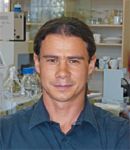
André de Villiers
From the point of view of Lauer, who is currently the managing director of HLCE and was one of de Villiers's supervisors of his masters and PhD theses, the timing of de Villiers's decision was perfect, given the changes that were going on at Stellenbosch University at the time. Ben Burger, a professor and the director of the Laboratory for Ecological Chemistry (LECUS), had decided that Stellenbosch University needed a chemistry department with a focus on separation science, so he enlisted Pat Sandra, who was then at the University of Ghent and also a director of his own Research Institute of Chromatography (RIC), to set up such a department. According to Lauer, Sandra made sure that a strong program was established, and he imported a lot of instrumentation from Europe and helped secure funding for the new department. "De Villiers brought his talent at the right time and the right place," said Lauer. "He showed his talent with excellent study results, a great understanding of the analytical problems, and use of the instrumentation available then."
De Villiers did his postdoctoral studies at the Pfizer Analytical Research Centre (PARC) at Ghent University in Belgium, from 2004 to 2006. From there he decided to return to Stellenbosch University as a lecturer in chemistry, a position he held from August 2006 to July 2008. In August 2008, de Villiers was promoted to senior lecturer of chemistry, and he remained in that position until December 2012. In January 2013, he was promoted to associate professor of chemistry and continues to hold that position today.
Contributions to the Field
De Villiers's research interests include fundamental studies that push the boundaries of the chemical characterization of complex mixtures using state-of-the-art techniques such as multidimensional LC and GC combined with MS, and the application of these methods, primarily to natural product analysis. He has published 50 papers in peer-reviewed journals, and his papers have been cited 925 times — quite an accomplishment for such a young scientist!
Sandra, who is now an emeritus professor with the Research Institute for Chromatography and was de Villiers's professor and thesis supervisor at Stellenbosch, feels that de Villiers's greatest contribution to the field of separation science so far is his work developing new LC methods and techniques, including comprehensive LC×LC for the analysis of natural products, such as South African wines.
Lauer agrees, citing "his endeavor to understand and nail down the complexity of molecules that define the color, taste, and bitterness of South African wines with all the available separation techniques he could lay his hands on."
Tadeusz Górecki, a professor at the University of Waterloo, said he values de Villiers's contributions to the area of multidimensional LC "from his early work with Isabelle François to his recent foray into hydrophilic interaction reversed-phase LC×LC." Górecki also mentioned that de Villiers's more theoretical work, such as his papers on kinetic optimization of LC separations, are also of high quality.
Emily Hilder, a professor of chemistry and director of the ARC Training Centre for Portable Analytical Separation Technologies at the University of Tasmania (as well as the 2012 LCGC Emerging Leader in Chromatography award winner), agreed with Górecki's thoughts on de Villiers's contributions in multidimensional LC. "His work has demonstrated how 2D LC can be applied to the analysis of very complex samples from natural products (wine, food, and so on)," said Hilder. "Such practical applications of this technology are what is needed to guide future developments."
Scientific Accolades
De Villiers has received a number of awards from the separation science community, including the 2009 Csaba Horváth Memorial Award from the International Symposium on High-Performance Liquid Phase Separations and Related Techniques (HPLC) and the 2012 Chromatographer of the Year award from the Chromatographic Society of South Africa. He has also been invited to deliver lectures at prestigious international conferences, such as HPLC and the International Symposium on Hyphenated Techniques in Chromatography.
De Villiers is currently chairing the Western Cape board of the Chromatographic Society of South Africa. He was also responsible for the organization of two successful conferences that took place in Stellenbosch: the 39th National South African Chemical Institute convention in 2008 and Analitika 2010.
Future Contributions
Given what de Villiers has already accomplished in his career, we asked several of his mentors and peers where they thought his work might take him.
Sandra expects de Villiers to make contributions to the fundamental understanding of chromatographic processes, because he has a very strong theoretical background. He also thinks de Villiers will play an important role in education. "He will definitely have a great impact in the education of students in Africa on state-of-the-art analytical techniques and, more specifically, chromatography and electrophoresis combined with high-resolution mass spectrometry," said Sandra.
Górecki feels de Villiers will continue the legacy of other great South African separation scientists, like Victor Pretorius or Ben Burger. "He has already made his mark on separation science, and the trajectory from here can only be up, especially knowing de Villiers's talent and work ethic," Górecki said.
Barend (Ben) V. Burger, an emeritus professor from Stellenbosch University, thinks that de Villiers might branch into GC, even though that is not his primary area of research. "I think there is still much scope for the development of more affordable two-dimensional instrumentation," said Burger.
Frédéric Lynen, an associate professor at Ghent University, said de Villiers's research would continue in natural product analysis with the "discovery of new, thus far, biologically active compounds via the combination of high-end chromatography and the elucidation of structures of unknown natural solutes."
A Testament to De Villiers's Character
Other scientists describe de Villiers as friendly and down to earth. Hilder recalls first meeting him at an HPLC conference in 2006, and said their friendship has grown since then. "The separation science community is very supportive and there is now a good group of young people all at a similar stage in their careers," she said. "We catch up at meetings, and this makes for a great, fun support network of scientists for bouncing off ideas and sharing advice." Hilder also said that she shares a love of cricket with de Villiers.
De Villiers is indeed a big sports enthusiast — not just as a fan, according to Górecki. De Villiers regularly plays pickup football games, and is an avid biker and an aspiring surfer. "He often comes to the university in the summer with a surfboard attached to the roof of his car," said Górecki. "This earned him the nickname 'Professor Dude' among his students."
Górecki shared a story about de Villiers's participating in a grueling bike race around Cape Peninsula that is more than 100 km long and has numerous climbs and strong winds. Several years ago de Villiers crashed and injured himself rather badly, so he could not complete the race. It took several hours for an ambulance to reach him. "De Villiers declared that he would never do that race again and stopped biking entirely. After a few months, though, he registered for the next year's race and started to train again," said Górecki. "This dedication is what drives his career as well."
Lynen paraphrased one of de Villiers's favorite quotes: Something worth doing is worth doing well. "I always found this phrase very characteristic of his personality," said Lynen. He also mentioned a research problem that de Villiers worked on in 2003 to address peak distortion problems when drawing the calibration lines of organic acids in capillary electrophoresis. Lynen explained that the problem looked very strange and difficult to solve, but de Villiers was able to correctly deduce that the increasing concentrations of each organic acid calibrant were effectively lowering the pH of the migrating zone and, as a result, creating an electrodispersion phenomenon that could be fixed by adjusting the sample pH (2). "The meticulous approach with which he addressed that problem (also by studying a lot of literature on the topic) was very impressive and demonstrated the eye for detail that is characteristic of a true scientist," said Lynen.
More About the Winners
In-depth interviews with Fred E. Regnier and André de Villiers, focused on their research, challenges, and accomplishments will be published in upcoming editions of our newsletter, E-Separations Solutions.
References
(1) Fred Regnier's Indy 500 of Chromatography and Other Stories, available at: http://www.blurb.com/bookstore/invited/3531763/965fa935d167f1c23c7e4c18630aff06249d65b6?ce=blurb_ew&utm_source=widget (2013).
(2) A. de Villiers, F. Lynen, A. Crouch, and P. Sandra, Eur. Food Res. Technol. 217(6), 535–540 (2003).
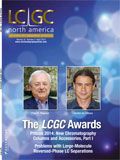
Reversed-Phases for LC Deliberately Doped with Positive Charge: Tips and Tricks for Effective Use
May 13th 2025In this month's edition of LC Troubleshooting, Dwight Stoll and his fellow researchers discuss both the benefits (improved peak shape/loading) and challenges (excessive interaction) associated with charge-doped reversed-phase (RP) columns for both analytical and preparative separations.
Evaluating the Accuracy of Mass Spectrometry Spectral Databases
May 12th 2025Mass spectrometry (MS) can be effective in identifying unknown compounds, though this can be complicated if spectra is outside of known databases. Researchers aimed to test MS databases using electron–ionization (EI)–MS.
Discovering the Hidden Plastic in Garden Compost with Pyr-GC–MS
May 12th 2025An Australian study used pyrolysis coupled to gas chromatography-mass spectrometry (Pyr-GC–MS) to analyze the presence of plastic polymers in commercial and homemade composts. LCGC International spoke to Simran Kaur—a PhD candidate at the Queensland Alliance for Environmental Health Sciences (QAEHS) at The University of Queensland in Woolloongabba, Australia—to find out more about her team’s findings.

.png&w=3840&q=75)

.png&w=3840&q=75)



.png&w=3840&q=75)



.png&w=3840&q=75)










